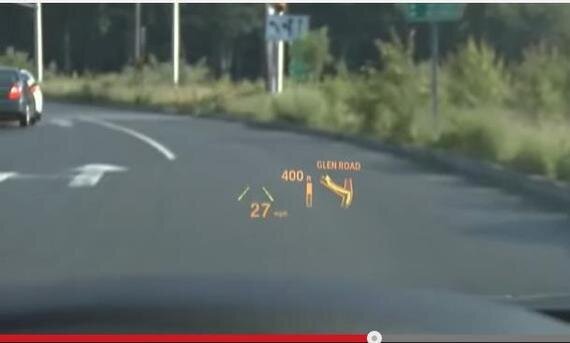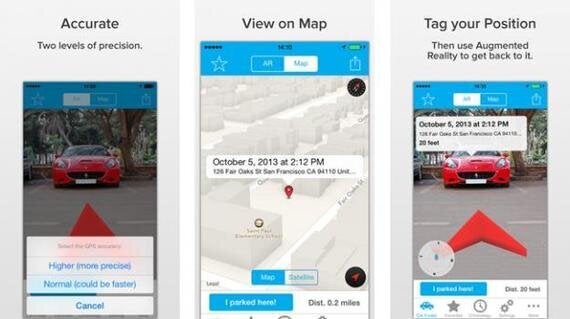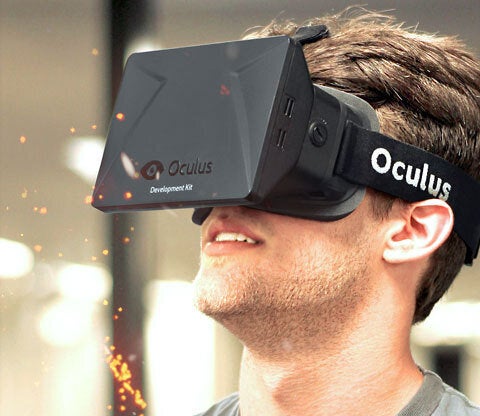For years I've been aware of a cool app that allows you to text while seeing where you walk to prevent accidents like falling over. This simple functionality in an app (and a more sophisticated app called Layer) use Augmented Reality. Though despite it being around for years, the integration and adoption of some technologies require a tipping point before they become mainstream. I believe that Augmented Reality (AR) is approaching this tipping point. Why do I think this? Well, the advent of cool gadgetry integrating this functionality has now brought it mainstream. Read on...
But first, let's define what AR is. According to Wikipedia, "Augmented reality (AR) is a live direct or indirect view of a physical, real-world environment whose elements are augmented (or supplemented) by computer-generated sensory input such as sound, video, graphics or GPS data."
In a nutshell, think of seeing information overlaid on your view of the real world. Think of Minority Report or the futuristic glasses in the Iron Man movies.
The reason I feel AR is 'tipping' is due to the combination of AR with wearable devices, an area so exciting that Mindshare have set up a dedicated unit to deal with the new 'third wave' in advertising! Wearable tech, for example Google Glass, as well as tablet and mobile devices, make the combination of merging reality with data more relevant (and practical!) than ever before. The technology now has purpose.
Car Head-Up Display (HUD)

As a lover of technology and gadgets, I am now the proud owner of what feels like one of the most technologically advanced car on the planet market. I ordered my car with appropriately titled "Head-Up Display" which is an overlay of information on your windscreen allowing you to keep your head up (and not look down) when driving in order to view details like your speed, sat nav directions, music playing or incoming/outgoing calls. Watch this video for a true understanding of the experience. More and more cars are including this option, even the latest Kia.
I've been using this feature for nearly a month and can honestly say I can't imagine life without it. I am sure it will be standard on all cars in the next 5-10 years.
Simply put, safety should always come first and not taking one's eyes off the road can only ever be a good thing. I can imagine the data displayed to evolve to being more "contextually relevant" for example background of buildings, nearest petrol stations (as already in sat nav), friends nearby (social media) to name a few ideas.
In the Sunday Times, there was recently an article on "one text proving fatal" as a lorry driver is sent to jail for 5 years while causing an accident while he was texting. Perhaps text integration with AR is the next step? Personally, I still think this is distracting (and therefore less safe) despite one's eyes still being on the road. Think about how concentrated you are on the road when taking a hands-free call while driving... ?
Smartphone Augmented Reality (AR) Apps
There is currently a broad range of helpful and practical (and cool!) apps using this technology. Have a look at this Top 10 list, for example "Augmented Car Finder", literally guiding you to where your car is parked, or "Lookator", showing the nearest wifi hotspots to you and indicating their strength. Another list of great AR apps is available here. Caveat, some may only be available in the US and some are only Android/iPhone apps.

Another interesting app is Gizmag, which turns your phone into head-up display.
AR Contact Lenses
On the commercial side, AR was used in marketing of the movie Mission Impossible (MI4 Ghost Protocol) with a mobile app using AR to play trailers and provide information about the movie by pointing the app on the movie posters or advertisements. In the actual movie, they used contact lenses developed by Microsoft integrating AR.
Google Glass
In June 2014, Google Glass launched in the UK bringing AR to the market for the first time in the form of a wearable consumer product. The press are sceptical about consumer adoption, not due to the £1k price tag, but more the self-consciousness of interacting with the device (and looking like an idiot) in public. The press fondly refer to users as 'glassholes'. Ouch.
I am mildly impressed by the array of trendy spectacle frames they have brought out but I really think that Google should focus more on where the product can add value in the B2B sector then the actual style of the frame. In the B2B sector, I can think of many useful applications of the product, combining a portable webcam and conferencing tool (think Go-Pro meets Skype) in hands-free format.
Here are some ideas (which may already be out there):
- In the medical field, for students or peers to shadow or advise doctor's across geographical locations. For example, a dermatologist may easily get a second opinion whilst wearing the glasses or a trainee surgeon can be talked through an operation with an expert watching whilst providing guidance. I have no doubt this is already in the pipeline.
- For estate agents, providing a live showing experience for potential customers who cannot get away for a critical viewing
- For architects, interior designers and builders, to assess situations and enable discussions without being present
- For art or jewelry buyers, to view an item without physically being present
- In the educational field, for teachers and assessors to judge students' performance in a practical exam
- In museums, to explain about a work of art or artifact while the user is looking at it
My advice to Google is to take a page from the Apple playbook and focus less on the product and more on what the product can do. As sales people should know (and as I teach), it's not about the feature but the benefit. To take it one step further, Apple actually show the iPhone benefits (and how to use them) in their commercials. Google should give glasses to the target audiences mentioned above to help show how the product adds value beyond that of being on a trapeze (this in the actual demo video). Incidentally, any sane person would just use a Go Pro then risk their glasses falling off (side note: I love the Go Pro website with the video of the kid with his dad on a surfboard on their homepage! What a gorgeous example of emotive website design).
Microsoft Headband
Microsoft is going to make Google sweat a bit with their not-so secret British trial of a rival to Google Glass "billed as the ultimate navigation aid to modern life". Users slip on a "smart" headband as an alternative to glasses. Which user will look dorkier? Only time will tell. Hailed actually as a product for the blind, it can obviously be equally used in all the above-mentioned situations.
Virtual Reality (VR) Gaming

Have I left you somewhat excited about Augmented Reality? I hope so, though I'm still waiting though for my bathroom mirror to show me the weather and news headlines in the morning as an alternative to my own groggy face...